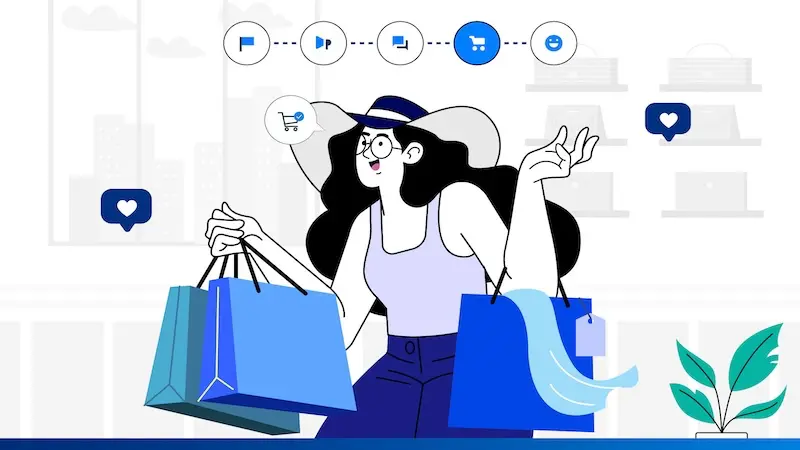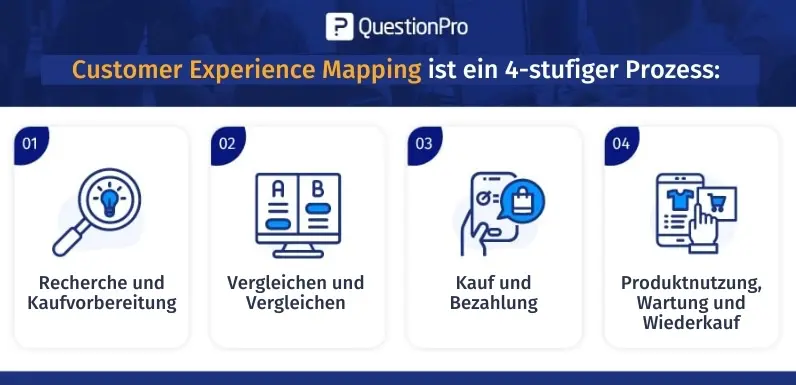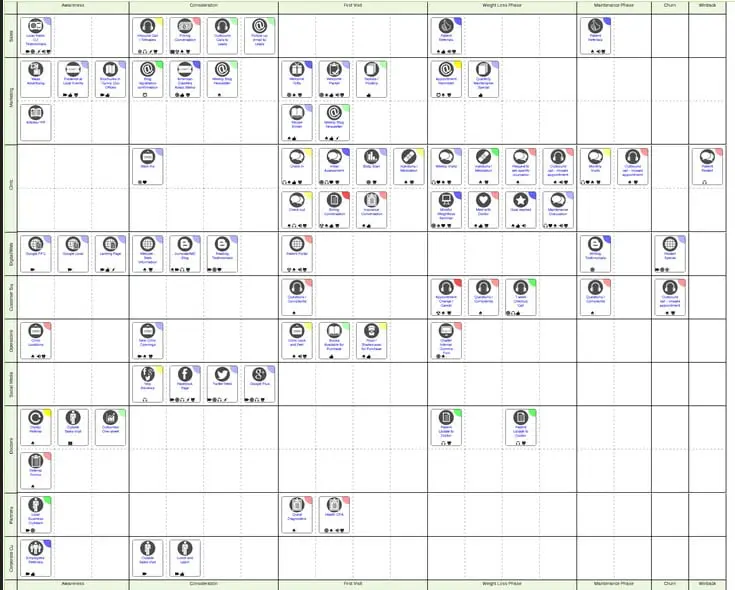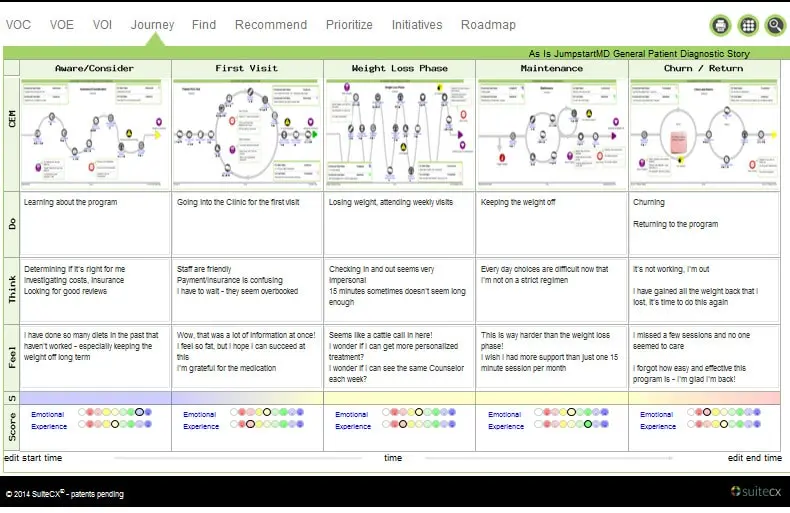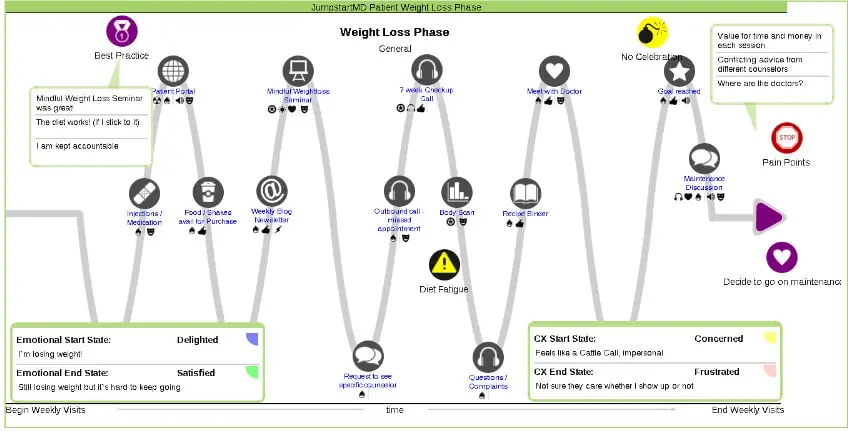Customer Experience
Customer Experience Mapping promotes customer engagement. Today's customers expect companies to be proactive rather than reactive and to anticipate customer wants/needs.
To work effectively (and profitably) with the new omnichannel customer, we must “see” and respond to the behavior and information the customer provides in each channel.
The suggestion is to provide a seamless customer experience, but implementing it is harder than it sounds. So how can we appeal to this fickle consumer who goes from online to offline and doesn’t think about the fact that they “shop” in different ways? By creating a great customer experience:
- Customer Experience Mapping to “see” your customers, both their rational and emotional mindsets.
- CRM infrastructure/technology to communicate, manage and track customer engagement across all channels.
- Organisational alignment and employee engagement to bring the brand to life.
- Continuous innovation to support the entire brand experience.
- Metrics and dashboards to prove ROI and share successes.
Today we will focus on the first step, customer experience mapping. This step is about understanding what the customer thinks, feels and does when they interact with the brand and share the brand promise.
CONTENT
- 1 Customer Experience Mapping: Where to Start?
- 2 Examples of customer experience mapping
- 3 How does customer experience mapping contribute to improvement?
- 4 Find out how QuestionPro can help you improve customer experience
- 5 1:1 Live Online Presentation: QUESTIONPRO CUSTOMER EXPERIENCE SOFTWARE
- 6 Try software for market research and experience management now for 10 days free of charge!
Customer Experience Mapping: Where to Start?
Customer Experience Mapping is a 4-step process:
- Research and purchase preparation
- Compare and compare
- Purchase and payment
- Product usage, maintenance and repurchase
The experience typically begins with an analysis of the purchase journey, starting with the “research” or pre-purchase phase, where customers learn about your products or services through research, word of mouth, social media, etc.
Did you know that 60-70% of your customers already know what they want BEFORE they come to your website or store?
To do this, you need to develop and understand the psychology/personality of your customer segments. Each segment has different behaviors, emotions, and goals, so we begin the process by mapping each group.
The second step is the shopping and comparison phase, where the customer actively compares products, features and prices before making a decision.
The third step is purchase, where the customer buys the product or service. In the final step, the customer experiences your product or service and needs help with a question or service. These days, both good and bad experiences are shared via social media.
The actual process of customer experience mapping begins with an “inventory” of contacts to determine who is actually in contact with customers. This can be quite a surprise.
Typically, the process also includes customer surveys and observational data that document how customers interact with the brand online and in stores. Additionally, it is important to capture the interactions and contributions of frontline employees to understand the customer perspective. Together with an analysis of the company's procedures, processes and guidelines, this results in a 360-degree view of the environment.
Once completed, the emotional and rational elements of the customer lifecycle are visually represented in a detailed map. They should highlight what pleases them or hurts them, as well as the “moments of truth” in decision-making.
Examples of customer experience mapping
With these customer experience mapping examples, we can easily see how they can help companies identify pain points, optimize interactions, and ultimately increase customer satisfaction.
Customer Experience Storyline
This, along with supporting facts and images, is used by the organization to “see” at a granular level what needs to change and how it will impact the customer experience. It becomes the reference point for the transition to an improved process.
Many companies convert the maps into short videos where they can continue to visualize the current customer experience and what it will look like once the deficiencies are addressed and improvements are made.
The new experience is not just about filling the gaps in the customer experience. It's about fully understanding the customer's emotions, behaviors and motivations to create a new experience that enables a shorter, more profitable path to purchase and lasting loyalty.
Learn more about Story Mapping.
How does customer experience mapping contribute to improvement?
The map helps you prioritize your actions and drive initiatives to:
- Improving the customer experience across the organization, at all customer touchpoints.
- Align the organization across all media and departments for a better experience. This is their most important goal.
- Focus: A great customer experience should be the focus of all your interactions, not just purchases or repurchases.
- Put yourself in the customer's shoes: The customer experience should be based on the customer's individual segments/personalities and preferences, including interests, media mix, frequency of contact, cadence, timing, etc.
- Test and Learn: Supports a continuous learning process that changes over time. Requires a test and learn culture with analytics and metrics.
When companies show their customers that they understand and value them through personalized and consistent interactions, they achieve better financial results.
Find out how QuestionPro can help you improve customer experience
Our software can help you improve the customer experience in many ways. You can create and visualize the customer journey, identify pain points, and develop solutions that optimize interactions to increase satisfaction.
QuestionPro CX tracks customer interactions across multiple touchpoints, including our website, social media and customer service channels.
Additionally, you have a closed-loop management system that allows you to resolve issues in real time and send intelligent notifications to customer service agents to mitigate negative experiences.
Request a demo now!
1:1 live online presentation:
QUESTIONPRO CUSTOMER EXPERIENCE SOFTWARE
Arrange an individual appointment and discover our market research software.
Try software for market research and experience management now for 10 days free of charge!
Do you have any questions about the content of this blog? Simply contact us via contact form. We look forward to a dialogue with you! You too can test QuestionPro for 10 days free of charge and without risk in depth!
Test the agile market research and experience management platform for qualitative and quantitative data collection and data analysis from QuestionPro for 10 days free of charge
FURTHER KEYWORDS
SHARE THIS ARTICLE
KEYWORDS OF THIS BLOG POST
Customer Experience Mapping | Customer Experience | Mapping
FURTHER INFORMATION
- The 11 best 360 degree feedback tools
- Qualitative feedback: The importance for your company
- 270 degrees feedback: what is it, features and examples?
- Evaluation of 360 degree feedback: Make optimal use of results
- Closed-loop feedback: what it is, importance and best practices
- Sentiment analyses and semantic text analysis based on artificial intelligence
- All information about the experience management platform QuestionPro
- Conducting employee surveys: A specialist article from QuestionPro

